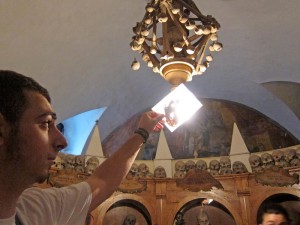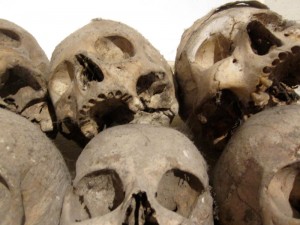Without its mummies, Urbania would be dead to tourists, and the economy might be moribund.
URBANIA, Italy — The mummies of Urbania are all about keeping up appearances.
Pinned to the wall in awkward standing positions, the 18 dessicated bodies have yellowed skin that hangs off them like deflated and torn paper balloons encasing dehydrated organs.
Without lips, the corpses have no choice but to grin as camera flashes bounce off the glass that separates living from the long dead.
These mummies are the celebrities of Urbania, bringing in more tourists than any other attraction in the town of 7,000. Last year, 10,539 tourists visited the home of the mummies, La Chiesa Dei Morti, or the Church of the Dead, according to the Tourist Information Office.
That’s about 36 percent of all tourism in Urbania. Without the mummies, Urbania would not receive nearly the amount of attention it now gets, nor the 2 euro admission from each visitor.
“Tourism is important for this little town as it is for the rest of Italy, of course,” said Dr. Feliciano Paoli, director of Urbania’s library and civic museum, through an interpreter. “Even more so in a moment of economic crisis, attracting tourists can be something valid to integrate the economy.”
Tour guide and custodian of the mummies, Giovanni Maestrini, 30, believes this attention comes from mankind’s unique curiosity.
[pullquote]We’re attracted by the macabre. There’s an interest concerning things that are unknown.[/pullquote]
“We’re attracted by the macabre. There’s an interest concerning things that are unknown,” Maestrini said.
Maestrini greets visitors with a wide smile, dressed casually in his Hard Rock Cafe T-shirt and shorts. He shuffles them past the 14th century decorations in the main chapel, and through a wooden door in the back.
Once he’s led visitors into the hallway, he steps back, offers a friendly “Prego,” (literally “you’re welcome”, but he means, “please proceed”), and allows them to walk up a few stone steps and into the museum alone to allow their first impression to sink in undisturbed.
The 18 mummies are arranged in a semi-circle, facing the center of the room, posed beneath 10 wooden arches. The only light is a chandelier made of bones found in the same cemetery as the mummies.
Maestrini steps into the room, and before describing the mummies behind him, he tells the story of how they came to be in the church.
They were pulled from a cemetery in Urbania, outside of a monastery which no longer exists, after the 1805 Napoleonic edict of St. Cloud that said that the dead must be buried outside city limits.
Surprised by the perfect state of their preservation brought on by a combination of the mold and climate, the authorities moved the mummies into the Church of the Dead where they could be preserved and researched. It wasn’t until 1983 that the mummies were opened to the public as a museum.
Once this history lesson is over, it’s time for the mummies to be introduced.

Nicola Alessandroni, 17, a tour guide in training, holds up the heart of a mummy who died while being stabbed at a dance party.
“This one was stabbed to death, during a dance party,” Maestrini said. He held up a plastic bag containing a sliver of the boy’s heart. There is a visible hole where a knife went through it.
Tourists gasp and some even look away, but Francesca Uccheddu stared unblinking.
“Oh, God, maybe the… the fact that we know how they died. It has been explained to me how they died. I didn’t expect we could get to know that, but there’s the heart… I saw the heart of one of the mummies,” Uccheddu said in disbelief. The 21-year-old Urbino University student was in Urbania just to see the mummies.
She was not alone.
Ezio Cester, 51, and his wife Patrizia Stefanel, 51, both from Treviso, said they probably would never have come to Urbania if it weren’t for the Church of the Dead.
“When we went to see the museum of Egyptian mummies we saw them covered, you don’t have the same perception,” Stefanel said, using her hands to shape invisible bandages.
“With the skin out like that,” Cester said, “and the fact that you know that those [Egyptian] corpses have been treated for mummification while these ones haven’t, leaves you a little abashed because here we have a conservation 500 years old quite real, visible.”
The Church of the Dead has caught the attention of more than tourists.
In 2010, the dramatic Italian TV show “Mistero” did an episode about the mummies, which included Maestrini.
The same year, National Geographic filmed the mummies.
Being able to view the mummies online or in a video shouldn’t stop potential visitors though, said David Fitch, 21, from Illinois, after visiting the museum.
“It’s just so interesting to find the mummies in their state that they were in when they died and so perfectly preserved the way they were,” he said. “I don’t think a picture can fully capture that.”
Multimedia
